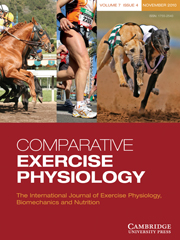Article contents
The effects of dietary manipulation and exercise on weight loss and related indices of health in horses
Published online by Cambridge University Press: 02 June 2009
Abstract
Obesity is considered a risk factor for laminitis, insulin resistance and other medical problems in horses. The objective of this study was to test the hypothesis that a feeding and exercise programme would induce weight loss and affect indices of health in overweight horses. Twenty-three overweight (BCS 6.5–9.0) QH and TB horses were assigned to three groups: calorie restriction (DIET), calorie restriction plus exercise (DIETX) and a control group at weight maintenance (CON). Measurements included body weight, body condition score, rump fat thickness, glucose, insulin, leptin, non-esterified fatty acids (NEFA) and triglycerides. Frequently sampled intravenous glucose tolerance tests measured insulin sensitivity (SI), glucose effectiveness and acute insulin response to glucose (AIRg). Disposition index (DI) was calculated. DIETX underwent a fitness test (graded exercise test) on a treadmill before and after the experimental period, and performed a standardized submaximal exercise regimen in an Equi-ciser™. Horses in the DIETX group lost more weight (P < 0.01) than DIET or CON. DIET also lost more weight versus CON (P < 0.05). All groups had decreases (P < 0.05) in BCS, with DIETX and DIET exhibiting the largest decreases. DIET and DIETX decreased (P < 0.05) in rump fat thickness. Cortisol decreased (P < 0.05) in DIET, and NEFA decreased in DIETX pre- versus post-weight loss. There were decreases (P < 0.05) in leptin and AIRg in DIET and DIETX pre- versus post-weight loss. DI was decreased (P < 0.05) in DIET and CON. SI was decreased (P < 0.05) only in CON. Calorie restriction and calorie restriction plus exercise programmes were successful in achieving weight loss in overweight horses. Indices of obesity, physiological stress and fat metabolism can be significantly altered with calorie control and exercise.
Keywords
Information
- Type
- Research Paper
- Information
- Copyright
- Copyright © Cambridge University Press 2009
References
- 15
- Cited by

